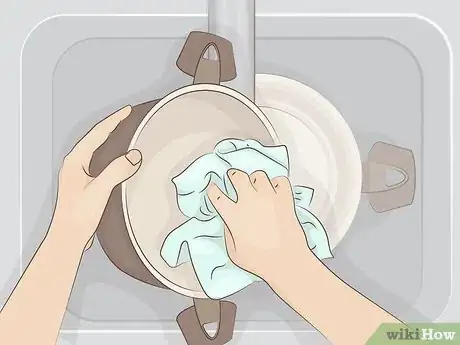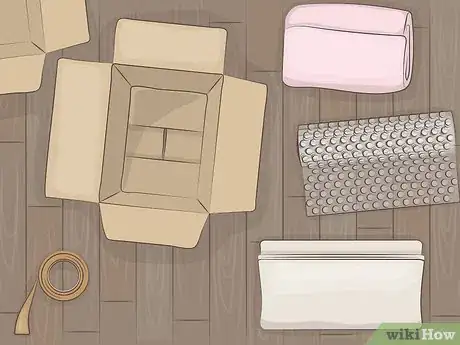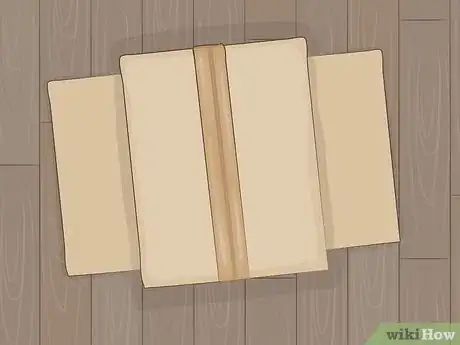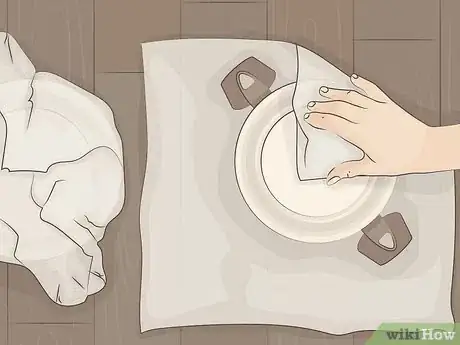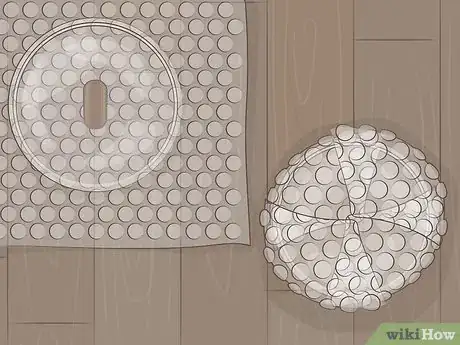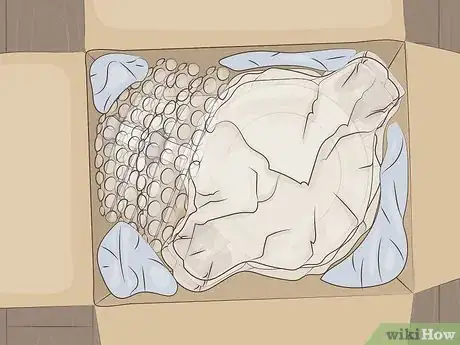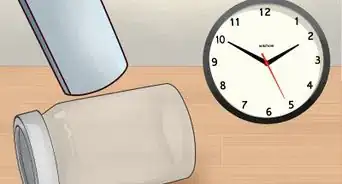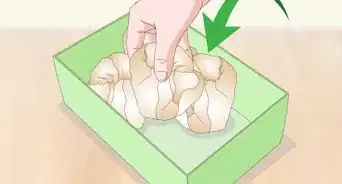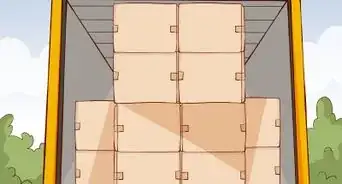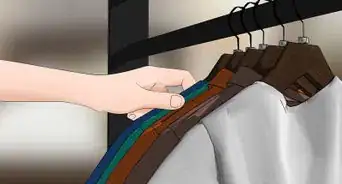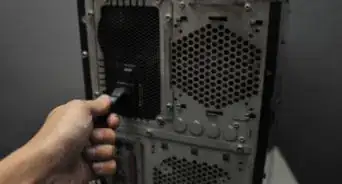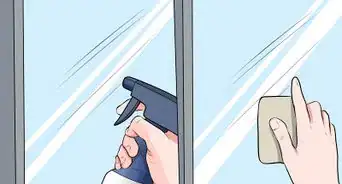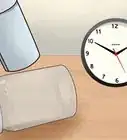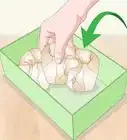This article was co-authored by Marty Stevens-Heebner, SMM-C, CPO®. Marty Stevens-Heebner is a Certified Professional Organizer (CPO) and Founder of Clear Home Solutions, a home organizing and senior moving management company based in southern California. Marty is the first Certified Senior Move Manager (SMM-C) in the United States and is a Certified Aging in Place Specialist (CAPS) through the National Association of Home Builders. She is the President-Elect and is on the board of directors of the National Association for Senior Move Managers, a member of the National Association of Professional Organizers, and has been acknowledged as a Hoarding Specialist and ADHD Specialist through the Institute for Challenging Disorganization.
This article has been viewed 20,161 times.
Pots and pans, although sturdy pieces of equipment, can suffer damage in a move like any other household item. A scratch to the surface of a non-stick pan could leave it ruined. Take care when packing your pots and pans by using a secure, durable box and separating out your pots and pans with wrapping paper, bubble wrap or spare dishtowels.
Steps
Preparing to Pack
-
1Clean your pans and pots. A dirty or wet pot could affect the material used to wrap or separate it from other items. Make sure the pots and pans are dry before packing; if the move results in any kind of storage time your items might develop mould.[1]
- This will also provide an opportunity for you to inspect your pots and pans before you go; therefore, if there is damage in the move you will be sure to notice.
-
2Gather materials for packing. You will need strong, good quality moving boxes, ideally of a medium size. Get packing tape and not duct tape. Acquire wrapping sheets or newspaper to separate out your items; to effectively secure fragile items, also acquire bubble wrap or use spare clothing or linen (dishtowels are ideal).[2]Advertisement
-
3Secure the bottom of the box with tape. A pot or pan is likely to be damaged if the box collapses. Apply strips of tape along the seams of the box, ensuring that it will be able to cope with the weight of the items.[3] The heavier the box the more tape you should apply.
Protecting Your Pots and Pans
-
1Sort pots and pans that can be nested. Pots and pans take up less space if they are stacked together—i.e. a small pot inside a medium pot inside a large pot.[4] Don’t force this if the pots are too tight a fit, it could cause damage.
- When nesting, align the handles to further reduce space.
- If a pot or pan is particularly valuable, or vulnerable to damage, consider packing in a small individual box or at least individually and not in a nest.
-
2Separate pots and pans with newspaper, bubble wrap or dishtowels. Sturdy as pots and pans might be, if they come into contact with each other directly when moving they could cause damage. Wrap the pots and pans completely in paper, and line the cooking surfaces, the most valuable area of the items, with the bubble wrap or dishtowel.
- Lining the interiors with dishtowels can also be used to make the pots level when stacking in a nest.[5]
- When nesting, start by wrapping the interior of the largest pot and then placing the smaller sized pot inside it. Repeat the step with the remaining pots, and then wrap as a whole.
-
3Take care with glass lids. It is a good idea to include the lids of your pots in the same box, so they don’t get separated in the move. Wrap the lids completely, as per the pots and pans, but take particular care with glass lids as these are easily broken. Wrap with a dishtowel or bubble wrap and then wrap again with paper.
-
4Leave no empty space. In order to avoid the packaged items moving while the box is in transit, make sure the box is full and items are secure before sealing up the box. Do this either by filling the remainder of the space around the packaged pots with scrunched-up wrapping paper, or using it as an opportunity to pack clothes or cushions.
- Do not add heavy items to fill the space. Pots and pans are already heavy and additional items could cause the box to become a hazardous weight.
-
5Seal each box and label it clearly. Use packing tape to seal the box; if the box is heavy take the same care in sealing the box as you did when you secured the bottom. Label the box with the room you want it delivered to, i.e. ‘kitchen’, and its contents. Label the box ‘heavy’ or ‘fragile’ if required.
Expert Q&A
-
QuestionIf I'm moving, where should I put the pots and pans?
 Marty Stevens-Heebner, SMM-C, CPO®Marty Stevens-Heebner is a Certified Professional Organizer (CPO) and Founder of Clear Home Solutions, a home organizing and senior moving management company based in southern California. Marty is the first Certified Senior Move Manager (SMM-C) in the United States and is a Certified Aging in Place Specialist (CAPS) through the National Association of Home Builders. She is the President-Elect and is on the board of directors of the National Association for Senior Move Managers, a member of the National Association of Professional Organizers, and has been acknowledged as a Hoarding Specialist and ADHD Specialist through the Institute for Challenging Disorganization.
Marty Stevens-Heebner, SMM-C, CPO®Marty Stevens-Heebner is a Certified Professional Organizer (CPO) and Founder of Clear Home Solutions, a home organizing and senior moving management company based in southern California. Marty is the first Certified Senior Move Manager (SMM-C) in the United States and is a Certified Aging in Place Specialist (CAPS) through the National Association of Home Builders. She is the President-Elect and is on the board of directors of the National Association for Senior Move Managers, a member of the National Association of Professional Organizers, and has been acknowledged as a Hoarding Specialist and ADHD Specialist through the Institute for Challenging Disorganization.
Certified Professional Organizer & Senior Move Manager Certified Professional Organizer & Senior Move ManagerExpert AnswerThe trick is to keep boxes organized based on the room they're going to end up in. So pack all of your pots and pans in a box with the rest of your kitchen stuff and label your boxes accordingly. This way, when you're unpacking, you can take the kitchen box where it belongs instead of accidentally putting it in your basement or something.
Certified Professional Organizer & Senior Move ManagerExpert AnswerThe trick is to keep boxes organized based on the room they're going to end up in. So pack all of your pots and pans in a box with the rest of your kitchen stuff and label your boxes accordingly. This way, when you're unpacking, you can take the kitchen box where it belongs instead of accidentally putting it in your basement or something.
Warnings
- Be aware of the weight of your box. Pots and pans, particularly those made with cast iron, can be quite heavy, and if you stack a lot in the same box it might cause the box to become a hazardous weight. If you have a large number of pots and pans consider packing them in separate boxes, amongst other items.⧼thumbs_response⧽
References
- ↑ https://www.kentremovalsstorage.com.au/moving-tips-and-tools/pack-pots-pans-moving-best-way-pack-pots-pans/
- ↑ Marty Stevens-Heebner, SMM-C, CPO®. Certified Professional Organizer & Senior Move Manager. Expert Interview. 14 January 2020.
- ↑ http://www.dhl.com/content/dam/downloads/g0/express/shipping/packaging/dhl_express_packing_guide_en.pdf
- ↑ http://guides.uship.com/moving/how-to-pack-your-kitchen/
- ↑ https://blog.hireahelper.com/get-a-handle-on-the-kitchen-a-sturdier-way-to-pack-pots-and-pans/
- ↑ Marty Stevens-Heebner, SMM-C, CPO®. Certified Professional Organizer & Senior Move Manager. Expert Interview. 14 January 2020.
